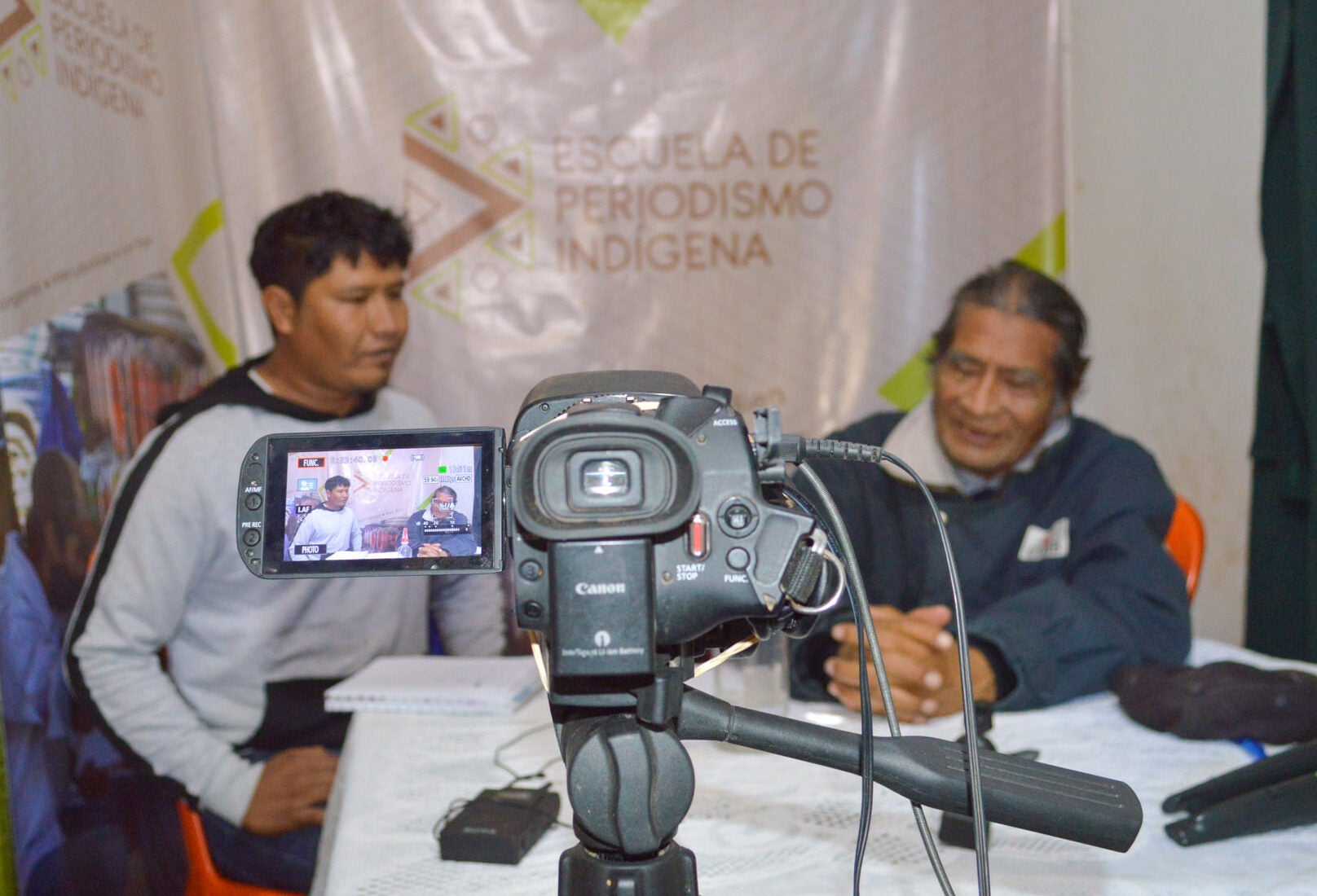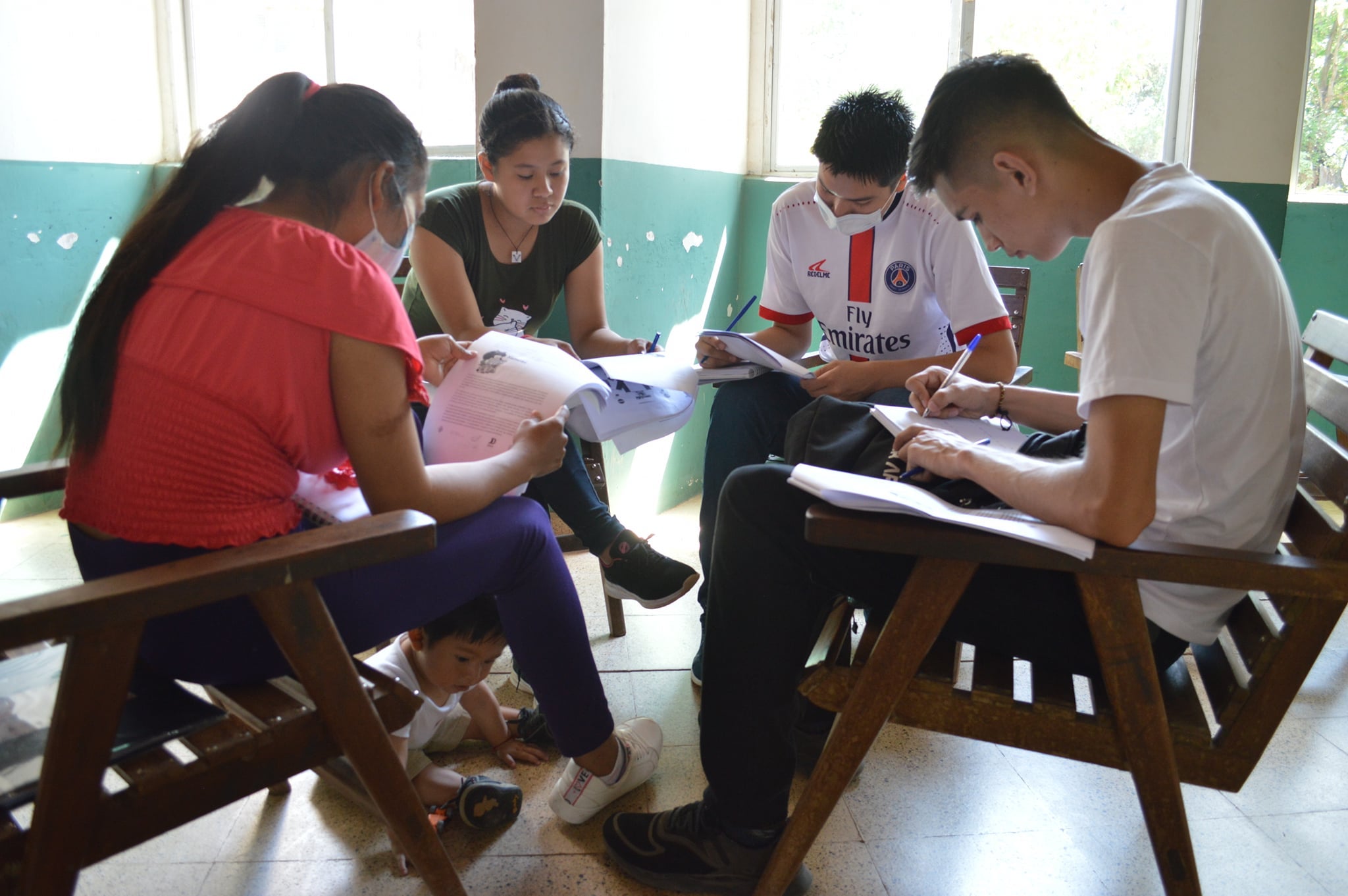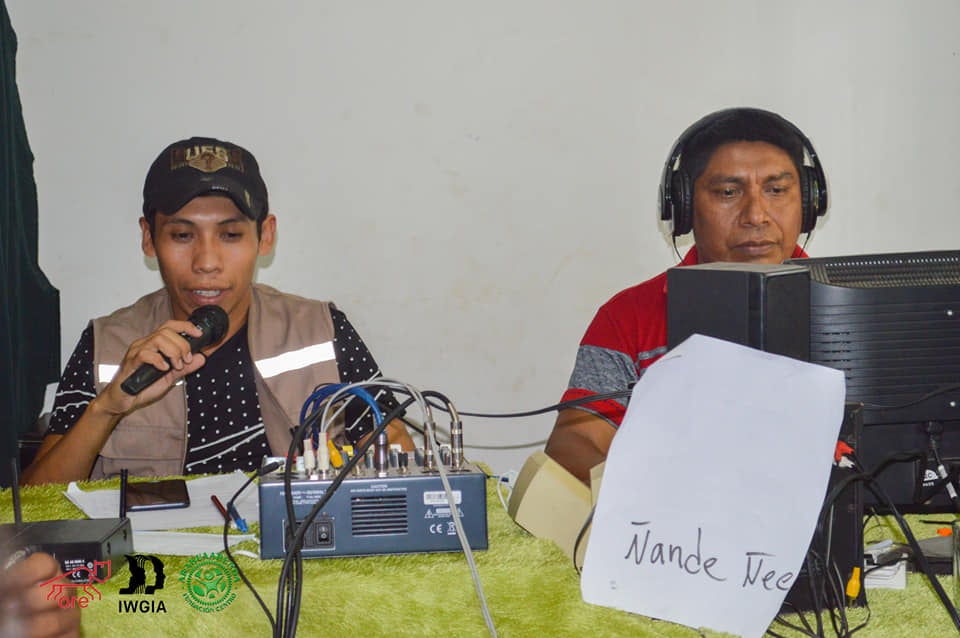Teresita Paredes made and sold traditional weavings from her community in the Guaraní autonomous territory of Charagua Iyambae, in southern Bolivia, when she learned that an Indigenous Journalism School (EPI) had opened in her town. It was October 2020, at the height of the COVID-19 pandemic.
She asked if she could enroll, but was told there were no spots left. If she wanted to take the classes, she would have to cover her own food and transportation. She was so interested in the program that she didn’t mind not receiving the support offered to registered students.
“Since I liked journalism, I wanted to know more about it,” Paredes told LatAm Journalism Review (LJR). “What they were talking about there was similar to what I was interested in, which was governance in Indigenous autonomies, the rights of our territories, and getting to know our land.”

The EPI has helped shape students’ sense of identity and communication, said its coordinator. (Photo: Courtesy Oré organization)
After attending the EPI, Paredes said she transformed from a shy young woman into a professional capable of hosting a radio program and speaking confidently in public. Now, at the age of 24, he has left weaving behind to take on the role of communications officer for the Council of Guaraní Captains of Santa Cruz, an Indigenous organization representing several territorial units of the Guaraní people in the department of Santa Cruz, where Charagua is located.
Like Paredes, other young Indigenous people have seen their lives change while Indigenous communities in and around Charagua now have more access to information, according to Elías Caurey, who heads the school and is a Guaraní writer and sociologist. The school links journalism to Indigenous identity, the preservation of native languages, and the defense of ancestral territory.
“The lives of the young people who have been part of the school have changed. It has shaped them in terms of identity and communication,” Caurey told LJR. “Some are now working in institutions, serving as communicators for their organizations, managing their social media pages. Others are already creating their own content.”
With funding from several international organizations, the EPI was founded in October 2020 as an initiative of Oré, an organization that supports Indigenous autonomies in Bolivia. These autonomies are a self-governing model recognized by the Bolivian Constitution that allows Indigenous peoples to manage their territories, institutions and norms according to their own traditions and forms of organization. In practice, however, they face a lack of resources, bureaucratic hurdles and limited institutional support from the state to function fully.
In 2017, Charagua became Bolivia’s first legally recognized Indigenous autonomy. The EPI was created to train Indigenous communicators from the region to be capable of reporting from and for their own communities.
“Our goal at the school is to support the autonomy process,” Caurey said. “To give students technical tools so they can put them into practice.”
Each academic cycle, the EPI invites Indigenous captaincies in Charagua to nominate young people to enroll in the program. Each captaincy sends its representatives with the understanding that, upon graduating, they will apply what they learned for the benefit of their communities, Caurey said.
Each class usually includes 28 students, who complete 10 or 11 modules. Classes take place at the Arakuaarenda Center Foundation, where students stay from Thursday to Sunday once a month for six months.
The curriculum includes not only training in writing, research and social media, but also a political component, with courses on governance, Indigenous law, the environment and autonomy, Caurey said.
“Sometimes young people come to realize that being Indigenous in these times can be difficult, especially speaking your language, and even more so when you’re young,” Caurey said. “So we have to strengthen the sense of identity, and from there, the political side as well.”

EPI students stay at an education center in Charagua from Thursday to Sunday once a month over a six-month period. (Photo: Courtesy Oré organization)
According to Caurey, the instructors include both professional communicators specialized in writing, investigative journalism and social media, and leaders and members of Charagua’s Indigenous autonomy, who teach topics related to governance, traditions and worldviews.
“I think the school has deepened that a lot, it makes people care and understand that our territory is very important to us,” Paredes said. “Not only to know it, but to protect it.”
Before the founding of the EPI, people in Charagua learned about national events mainly through radio, said Guaraní Indigenous communicator and EPI graduate Alex Pancho.
However, he added, radio rarely reflected the realities of Indigenous communities.
“The media didn’t talk about our daily lives or what was happening in our communities. So it was very hard for information to reach us. Very little came through the radio,” Pancho told LJR.
In five years, the EPI has developed several media outlets and information platforms that have positively impacted the Indigenous communities they serve, Caurey said.
One of these platforms is Paso a Paso con la Autonomía Charagua Iyambae, a Facebook page with more than 11,000 followers that covers local issues. The outlet is supervised by Caurey and Guaraní journalist Demetrio Mariano Vaca, but managed by about 20 young people. The page features stories that students and graduates produce about what’s happening in their communities, in both Spanish and Indigenous languages.
“Young people from different areas send reports about what’s happening in their regions — if there are assemblies, tournaments, demands or needs — and that’s shared on the page,” Caurey said.
The page publishes news about road blockades, sports events, Indigenous assemblies and cultural festivals.
There is also Ñane Ñee, a digital radio project whose name means “Our Voices” in Guaraní. It features two one-hour programs broadcast on weekends, including news, commentary and audience interaction, Caurey said. The Friday program is in the Chiquitano language, spoken by the Indigenous people of the same name in northeastern Santa Cruz, and the Saturday one is in Guaraní.
The EPI has also produced informational podcasts and a print magazine titled Revista Informativa Charagua Iyambae, which is published occasionally, Caurey added.
“The stories we publish, the demand for them, the communication and audiovisual products, the podcasts — they’ve made the EPI a reference point for content creation,” Caurey said.
In addition, the school’s journalistic work contributes to revitalizing Indigenous languages in the region, Pancho said.
“Nowadays, Indigenous languages are weakening, young people don’t speak them as much,” Pancho said. “As Indigenous journalists, we promote our languages through reports in Guaraní.”
Thanks to his training at the EPI, Pancho now works translating and recording content in Guaraní for Bolivia’s educational radio network Erbol. However, he still regularly reports for EPI media about events in his home community of Itanambikua, in the municipality of Camiri.

Ñande Ñee is a digital radio project managed by EPI students whose name means “Our Voices” in Guaraní. (Photo: Ñande Ñee on Facebook)
Another of the EPI’s priorities is to promote the defense of Indigenous territories. For this reason, the school’s media products also include artistic audiovisual productions that convey the importance of protecting Charagua’s nature reserves, Caurey said.
To achieve that, they’ve chosen a storytelling approach similar to the one the Guaraní have always used to express their worldview: through tales, legends and myths. This year, the EPI produced the medium-length film "Tarema," which uses fiction to depict the defense of Charagua’s protected areas from an Indigenous perspective.
“If you create protected areas and people don’t know them or feel connected to them, they won’t defend them. We believe the best way to contribute as Indigenous journalists is by showing these protected areas,” Caurey said. “Technical data is often hard for people to digest, so we’ve chosen to make it more artistic, more poetic. It’s a small part of what we do, not the main focus, but something we do as well.”